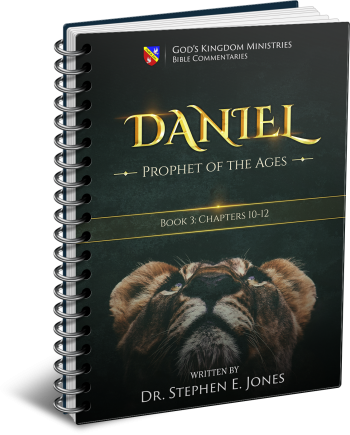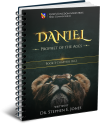Latest Posts
View the latest posts in an easy-to-read list format, with filtering options.

This is a commentary covering the last three of Daniel's visions in chapters 10-12.
Category - Bible Commentaries

The desecration of the temple, described in Dan. 11:31, was referenced earlier in Dan. 8:9-14. There it is given as the main feature of the “small horn” (or inferior horn) coming out of the third beast (the shaggy goat).
As we have shown, Antiochus Epiphanes fulfilled the prophecies of this horn. During his reign, the Prince of Greece, Vainglory, manifested himself in the clearest fashion. Dan. 8:11 says, “the place of His sanctuary was thrown down,” not in a physical sense, but spiritually. The next verse clarifies the manner in which the temple was thrown down, saying, “it will fling truth to the ground.”
On the physical side, Dan. 8:13 tells us that the holy place and the host were to be trampled. The “regular sacrifice” would be affected by this, “while the transgression causes horror,” i.e., “the abomination of desolation” in Dan. 11:31.
All of this took place, beginning in 168 B.C., when Antiochus dedicated the temple in Jerusalem to Zeus, or Jupiter, the King of the Greek gods. Because Antiochus was inspired by Vainglory, the Prince of Greece, this marks the apex of his power and manifestation in the earth.
Antiochus issued a decree mandating that all Judeans should worship at the same altar of Jupiter, convert to the Greek religion, burn all copies of the divine law, and stop the practice of circumcision. The penalty for non-compliance was death, usually by torture, not only to force compliance, but also to frighten others into submission.
There are some who think the third beast’s “rather small horn,” (NASB) is the same as the “little horn” that was to come out of the fourth beast (Dan. 7:8). Similarities between the two have caused some confusion, but it is clear that the two horns come from different beasts. In both cases their kingdom was extended. The Grecian empire was extended when Alexander’s kingdom was divided into four parts. The Roman empire was extended by a religious “horn,” which was centered in the Vatican.
Because both “horns” were ruled by carnally-minded men, they were inspired by “princes” other than the Prince of Peace. The main difference is that the “horn” of Greece attempted to establish Greek religion by violence and force, while the “horn” of Rome attempted to establish Christian religion by violence and force. These elements in common should not confuse us into thinking that these two “horns” were the same entity.
Daniel 11:32 says,
32 And by smooth words he will turn to godlessness those who act wickedly toward the covenant, but the people who know their God will display strength and take action.
Antiochus’ missionary zeal attempted to turn people to “godlessness” (from the angel’s point of view). When the Apostle Paul drew his prophecy from this history, he spoke of “the mystery of lawlessness” (2 Thess. 2:7) in contrast to “the mystery of godliness” (1 Tim. 3:16). The mystery of lawlessness (anomia) comes through “the man of lawlessness,” as Paul says in 2 Thess. 2:4,
4 who opposes and exalts himself above every so-called god or object of worship, so that he takes his seat in the temple of God, displaying himself as being God.
A few verses later, Paul tells us, “the mystery of lawlessness is already at work,” though restrained (2 Thess. 2:7). Hence, this was not a prophecy that was limited to the future, but one which already was seen in Paul’s day. The temple in Jerusalem had again been taken over by usurpers by the same spirit of lawlessness that had manifested itself in the time of Antiochus. The Prince of Peace had again been cast out of His own house, and His throne usurped by the chief priests in Jerusalem, who were inspired by the same Prince of Greece named Vainglory.
By usurping His throne, the vainglorious religious leaders in Jerusalem were acting as gods in their own right, playing the same role as that of Antiochus Epiphanes, “God Manifest.”
Paul tells us that this situation will change with the coming of Christ, whose true manifestation will expose (or manifest) the usurpers. The “lawless one” will then be removed, as Christ takes His throne, and his rule will be brought to an end by the epiphania of His coming.
This entire line of prophetic thinking was based on the story of David and Absalom. Absalom usurped David’s throne with the help of Ahithophel, David’s close friend and counselor (2 Sam. 15:12). But David eventually returned, and Absalom was killed (2 Sam. 18:15). In the New Testament story, Judas played the role of Ahithophel. Both men hanged themselves after their betrayals.
When the eleven remaining disciples met to replace Judas, they discussed the prophecies that were originally written about Ahithophel (Acts 1:16-21). This showed that they understood by this time how the story of David, Absalom, and Ahithophel prophesied of Christ and the chief priests who usurped His throne with the help of the betrayer, Judas.
Paul takes this story to another level by comparing it to Antiochus, who usurped the temple in 168 B.C., calling himself Epiphanes, “God Manifest.” The true Epiphany, Paul explains, is the manifestation of Christ. Even as David ultimately returned to his throne, so also will Christ return to His throne and end the rule of the usurper.
Paul explains the mystery of godliness in 1 Tim. 3:14-16 in the earliest creed (“confession of Faith”) on record:
14 I am writing these things to you, hoping to come to you before long; 15 but in case I am delayed, I write so that you may know how one ought to conduct himself in the household of God, which is the church of the living God, the pillar and support of the truth. 16 And by common confession great is the mystery of godliness:
He who was revealed in the flesh,
was vindicated in the Spirit,
beheld by angels,
proclaimed among the nations,
believed on in the world,
taken up in glory.
It is most interesting that this earliest creed would be a confession of faith in the mystery of godliness. Paul contrasted his confession with the mystery of iniquity, as if to compare the believers of the first century with those who refused to worship the abomination of desolation in 168 B.C. The true believers, who made the confession of the mystery of godliness, were “the pillar and support of the truth.” Those who had usurped the temple for themselves were like a false Epiphanes, who had cast truth to the ground.
The true epiphany, of course, is the glorious manifestation of the Sons of God, which is fulfilled through the feast of Tabernacles. We are the true temple of God, and Christ indwells us. The believers in Paul’s day did not have the magnificence of the earthly temple in Jerusalem, but they housed the glory of God, hidden in their bodies until revealed to the world by the epiphany of Christ in them.
In the time of Christ, the world of beasts was a combination of Greek culture and Roman law. Although the Romans governed the world, they adopted the Greek culture, and virtually all upper class Romans spoke Greek as well as Latin. The Roman gods were Greek gods with Roman names. The Spirit of Vainglory, then, was yet prevalent, even though the Prince of Rome was dominant.
For this reason, insofar as religion was concerned, the temple in Jerusalem reflected the mystery of iniquity that had been defined by Antiochus and his policies two centuries earlier. Many of the prominent priests, especially the Sadducees who were in control of the temple at that time (Acts 4:1), were heavily influenced by Greek culture and beliefs. Worship in the temple in Jerusalem had Judean forms around a Greek mindset.
A few centuries later, Greek philosophy and culture seemed to wane with the collapse of Rome. Yet the Greek mindset continued under the Roman cloak, and by this time it also had a strong influence in the Church. Scripture was usually interpreted according to Greek thought patterns, because the original Hebrew way of thinking was forgotten or treated as inferior. Many Church leaders developed the Greek allegorical interpretation of Scripture, cutting it loose from history, and often treating Scripture like the Greeks viewed their own religious mythology. The history in the Old Testament was interpreted as a myth with spiritual meaning.
This problem continues to persist in the Church today in many ways. The antidote is to read the Scriptures with a Hebrew mindset. The New Testament Greek ought not to be defined by Greek usage, but seen as a Greek expression of Hebrew ideas and images. Then we will be able to understand that the history of Antiochus Epiphanes and his desecration of the temple is the foundation of Paul’s images and metaphors in 2 Thessalonians. And when we combine the history of Antiochus with the biblical history of David and Absalom, we can get a more complete understanding of the mind of Paul.
In the twentieth century we see a reappearance of the New Testament problem. The fourth beast (with its “little horn” extension) has ruled the earth for two thousand years by Roman law, but in the past century it has promoted Greek culture. The time of the fourth beast technically ended in 1914-1917, as we have shown earlier. But because the Greek beast was deprived of a century from 163-63 B.C. on account of its desecration of the temple in Jerusalem, that century has been added to the end of their time in order to give the beast systems their full 2,520-year time to hold the Dominion Mandate.
This, then, has been a Greek century. It is as if Antiochus Epiphanes has risen again, inspired by Vainglory, and has cast truth to the ground. America was changed from a Republic to a Democracy. The mystery of lawlessness, including giving immorality and degenerate behavior the right to express itself, has progressed throughout the century.
In Paul’s day it was not lawful to preach the word in public. Teaching doctrines contrary to established Greek religion was allowed only in the privacy of one’s home. The same restrictions are steadily being put into place in America today. This has been the Greek century, dominated by the spirit of Vainglory, replacing truth with vain philosophy that is enforced by the iron might of Roman law. The laws are written with Latin terms, but the culture (and medicinal terms) are Greek.
Because we have seen the rise of the Prince of Greece in the past century, it is helpful if we understand the nature of that prince and his role in prophetic history. Not only does this apply to the time of Antiochus, but it also helps us understand Paul’s prophecies in the first century and how these apply to our own time as well.